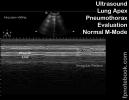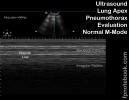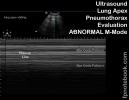II. Indications
- FAST Exam
- Pneumothorax Evaluation
III. Technique: Bilateral lung apices (part of Extended FAST Exam or eFAST)
- Transducer
- Linear probe (preferred) or
- Cardiac phased array probe (more convenient during eFAST Exam)
- Transducer positioning
- Placement: Lung Apex (3rd intercostal space in a supine patient), mid-clavicular line
- Axis: Long axis with indicator at 12:00
- Direction: Perpendicular to chest
- Landmarks
- Third rib (with shadowing)
- Third Interspace
- Chest wall
- Pleural line
- Sliding Lung Sign present (normal findings)
- Marching-ants appearance
- More prominent with color power doppler mode
- Changes on M-mode
- Top: Bar code pattern (skin to pleura)
- Bottom
- Normal: Seashore granular appearance (lung)
- Pneumothorax: Bar code throughout (known as stratosphere sign)
- Marching-ants appearance
- Artfacts
- A-Lines: Pleural line reverberation artfacts (horizontal lines at regular intervals)
- B-Lines: Comet tail artifacts (vertical wedges)
- Fourth rib (with shadowing)
- Images
IV. Interpretation: Pneumothorax
- B-Lines (ray artifacts) absent
- A-Lines present
- Typically present in Pneumothorax (and increases Test Specificity)
- Sliding-lung sign absent
-
Lung pulse absent
- Cardiac pulsation may normally be present when parietal and visceral pleura are directly opposed
- M-Mode with bar code appearance continuously from top to bottom
- Distinguish from heart motion artifact which can appear similar to sliding-lung sign
- Staying high in the chest (2nd intercostal space) avoids this potential False Negative finding
- Differential diagnosis of absent sliding lung sound includes apnea and shallow respirations
- Treat absence of Sliding Lung Sign with Chest Tube in a crashing patient with suspicion for Tension Pneumothorax
- May confirm absent Sliding Lung Sign by identifying the Lung Point
- Reasonable to obtain additional imaging to confirm Pneumothorax if patient stable without Tension Pneumothorax
- However, chest XRay Test Sensitivity for Pneumothorax is lower, especially in a supine patient
- Lung Point
- Can be used to estimate size of Pneumothorax
- Transition between normal lung and Pneumothorax
- Transition between Ultrasound seashore appearance and continuous bar code throughout
V. Diagnosis: Pneumothorax
- Sliding Lung Sign absent
- Test Sensitivity: 100%
- Test Specificity: 78% (see differential diagnosis below)
- Sliding Lung Signs absent AND A-Lines present
- Test Sensitivity: 95%
- Test Specificity: 94%
- References
VI. Differential Diagnosis: Loss of Sliding Lung Sign
- Pneumothorax
- Mainstem intubation (esp. loss of left sided lung sliding)
- Pleural adhesions
- Pulmonary fibrosis
- Lung Contusion
- Acute Respiratory Distress Syndrome (ARDS)
- Pneumonia
- Atelectasis
VII. Efficacy
- Single view (third interspace) for Sliding Lung Sign is equivalent to four view on each side (each 93% Test Sensitivity)
VIII. Resources
- FAST Exam - Pneumothorax (SonoSite)
- Pneumothorax (Dr. Perera, SonoSite)
IX. References
- Reardon (2016) Lung Ultrasound, Stabroom.com online video, accessed 4/1/2016
- Reardon (2013) Emergency Ultrasound Course, 3rd Rock Ultrasound, Minneapolis, MN
- Alameda County Trauma Service FAST Exam
- Mateer (2012) Introduction to Trauma Ultrasound Video, GulfCoast Ultrasound, VL-95-T
- HCMC FAST Exam






